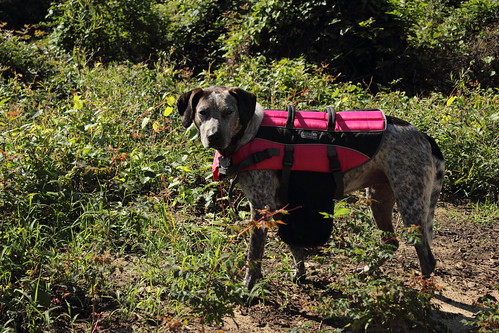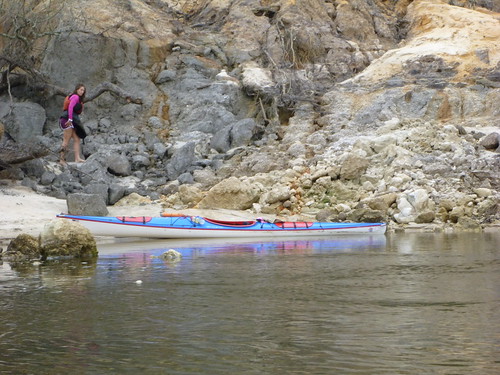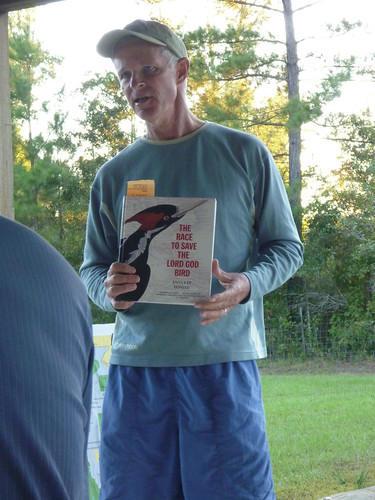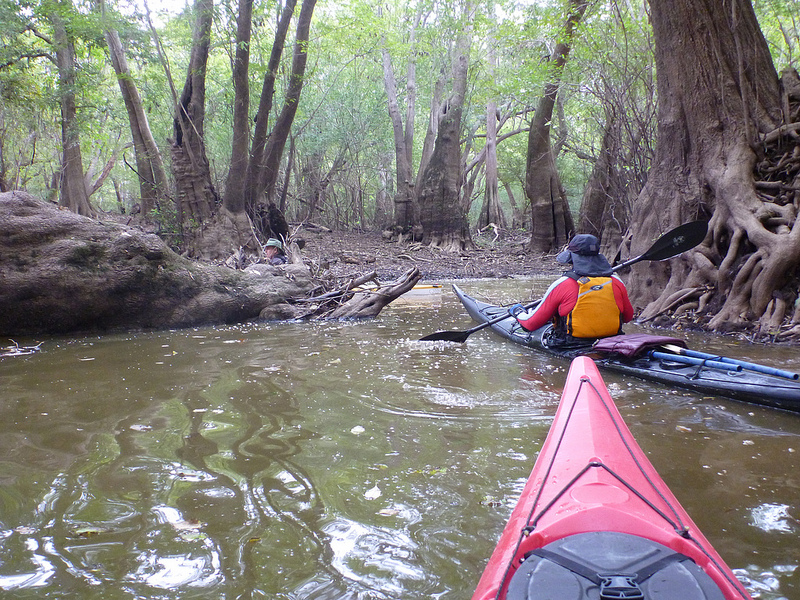Video: Kayak adventure in the upper Apalachicola, where we find Florida’s tallest river bluffs face a decades old man made threat. Also, higher water lets us deeper into Sutton Lake, a back woods swamp where the oldest and largest tupelo and cypress trees of the Apalachicola basin are found.
Plan your own Apalachicola River Adventure.
Rob Diaz de Villegas WFSU-TV
It’s amazing to see how much can change in one year on the Apalachicola River. I’ve previously mentioned the smaller sand bars and higher water. But the most striking visual difference is in the face of Alum Bluff, probably the iconic image of the upper river. In part 1 of this adventure, we approached it from land to be rewarded with possibly the best view of the river and the forest around it. In part 2, we kayak up to it.
Last year, we camped at the Alum Bluff sand bar across the river, and had activities in the evening and following morning that kept me from just being able to hang out and enjoy the bluff from my boat. As I did so this year, Alex Reed, our co-captain as well as a geologist, was inspecting the rubble from a landslide that occurred earlier in the year. Some of the rocks unearthed were millions of years old.
A few miles down the river, we explored an area that had been on my mind as RiverTrek approached. I was hoping that this year’s rain would let us penetrate deeper into Sutton Lake, a place that Dan Tonsmeire calls the “quintessential” backwoods swamp. That’s my favorite part of the video, as we make our way well past where we did last year.
As you paddle the big, wide Apalachicola, you pass so many creeks, sloughs, and other side channels. Behind the trees could be an Aspalaga Blue Spring (where we hiked in part 1), any branch off of the river might take you back to a dark, canopied swamp like Sutton Lake. The more I paddle the river, the more I am aware of how little of the basin I’ve actually seen.
It’s a lot to fit into two videos. I want to show you the river; that’s why I go. But we paddled with a lot of interesting people with some interesting stories, many of which I couldn’t fit into the videos without making a full blown program of it (maybe I should do that… would any of you watch it?). Here are a few interesting bits about my fellow RiverTrekkers:
George Blakely and Zone 5
 In several shots, you see a dog running across the mouth of a cave, down a steep path, or sitting calmly in a canoe. That’s Zone 5, a rescue dog that accompanies George Blakely on his adventures (she even has her own pink personal flotation device). George explains where he got such a cool name.
In several shots, you see a dog running across the mouth of a cave, down a steep path, or sitting calmly in a canoe. That’s Zone 5, a rescue dog that accompanies George Blakely on his adventures (she even has her own pink personal flotation device). George explains where he got such a cool name.
“In photography, Ansel Adams, he had his own system for the different tones, zones zero through nine. Zone five is middle grey. When she runs really fast, which she does frequently, except when she’s in the canoe, she’s middle grey.”
Todd Engstrom
Todd is an ornithologist with a unique history with the Apalachicola. He was sent to look for evidence of a bird that was thought to have been extinct for several decades. The ivory billed woodpecker is one of the largest species of woodpecker in the world, measuring about 20 inches long. When one was thought to have been sighted in Arkansas (a sighting that is now in doubt), The Cornell Lab of Ornithology sent Todd to scour likely habitat in the Apalachicola River basin. As opposed to the red cockaded woodpecker, which prefers upland forests, the ivory billed prefers lowland, old growth forests. Todd spent four months searching, from Lake Seminole to the bottom of the river.
“As a consequence of that, I was camping out, boating on the river, going to field sites. Just really enjoyed it. Fell in love with it.”
Chris Robertson
Chris is a returnee from RiverTrek 2012, and one of our co-captains. For him, a highlight of the trip came on the third morning.
“It was the time of the trip when you could finally let go of everything that goes on back in the quote-unquote real world, and just kind of immerse yourself in the river and what you’re doing. When you reach that point, it’s very emotionally and spiritually recharging.”
I get was Chris is saying. After a couple of days, the trip starts to feel like your reality. You’ve woken up a for couple of mornings where you stick your head out of your tent and see the river. Last year, I had a similar experience on the third day. I spent some time paddling alone, where the only visible signs of civilization were within my kayak. One of my favorite things about the trip is the people, but I treasured my one-on-one time with the river.
Who knows what my next adventure on the Apachicola River Basin will be (click the link- there have been many since). RiverTrekker Mike Mendez has talked about an extended trip starting on the Flint or Chattahoochee. Doug Alderson is mulling a hiking trip in the many protected lands around the river. I’ll be planning other EcoAdventures around the area, all the while knowing that there is some corner of the river basin that needs to be further explored.
Next on In the Grass, On the Reef
The Gulf Specimen Marine Lab takes their critters on the road. Meanwhile, back at their aquarium, tentacles are a-flailing over a tasty treat and marine megafauna try to eat our GoPro camera. Also, I begin a new adventure as a member of the Florida Greenways and Trails Council. I’ll give you the lowdown as the Council looks for ways to connect existing trail systems and create more opportunities for the kind of multi-day EcoAdventure featured in our RiverTrek videos.




